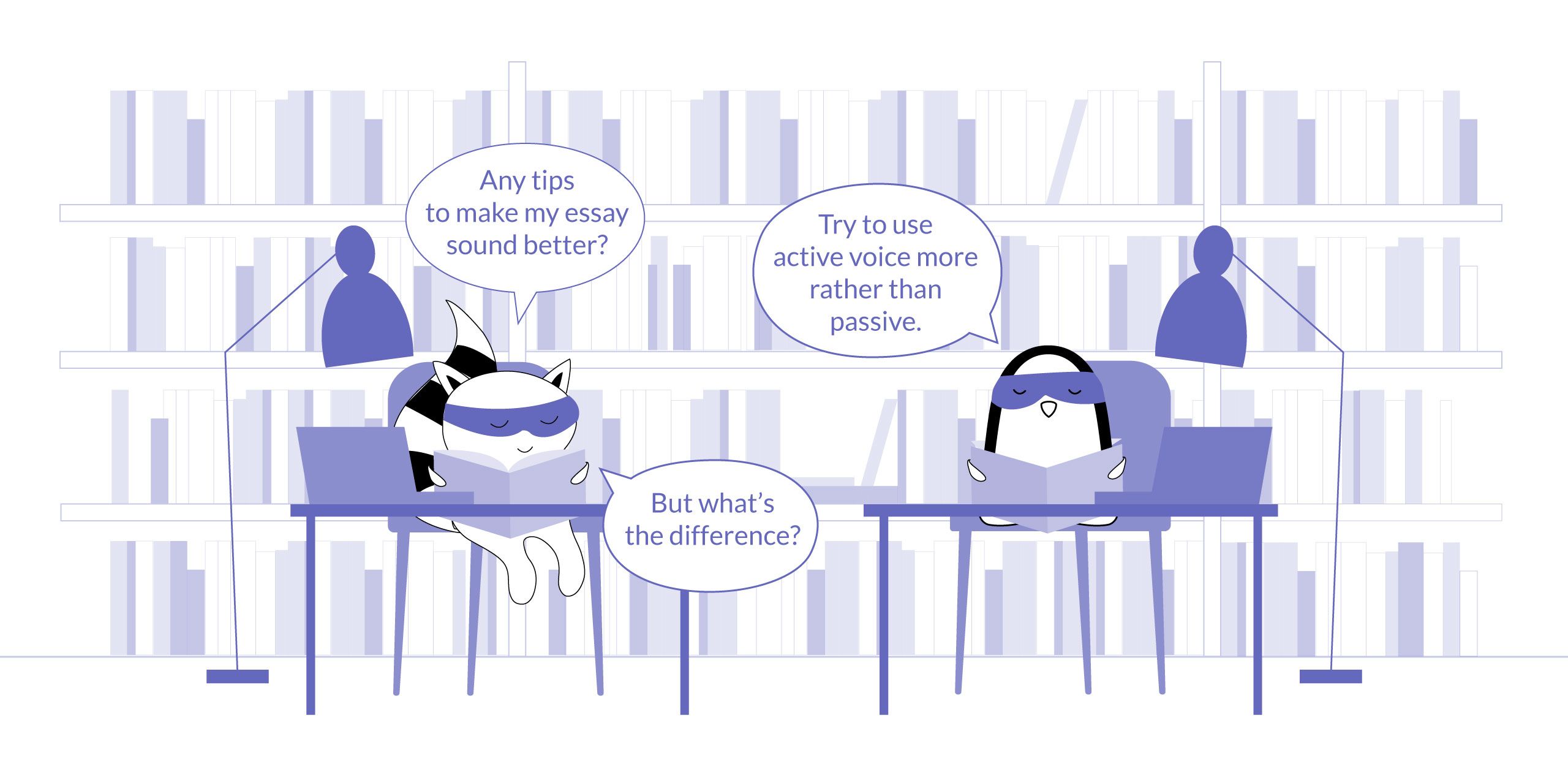
Sometimes, English grammar can get tricky and challenging to understand, especially for beginners. However, you shouldn’t get discouraged. With clear explanations and lots of examples, you can tackle every new grammar unit with no hesitation.
The active and passive voices of English grammar are just one of them! Do you know the difference between the active and passive voice? Most people don’t, but you shouldn’t be afraid to learn. Knowing this will help you improve your writing in English.
The passive voice can often be used in writing to make sentences sound more concise and elegant, but it's important to use it sparingly. The active voice is more direct and punchy, which makes it a great choice for most types of writing. Let’s learn when to use each one for best effect!
Learn English with Langster
When and How to Use Active Voice Correctly?
You use the active voice to make your writing more direct and concise. In an active voice sentence, the subject of the sentence does the action, instead of being acted upon. This makes your sentences more powerful and easier for readers to follow.
There are a few times when it’s best to use passive voice instead. If you want to downplay the importance of the subject, or if the subject is unknown, the passive voice can be a good choice. For example, “A new study was released today,” sounds more objective than “We released a new study today.”
In general, though, the active voice is the way to go. It’s more precise, easier to read, and sounds more natural. Next time you’re editing your writing, see if you can convert any passive voice sentences into active voice sentences.
Benefits of Using the Active Voice in Sentences
When you use an active voice sentence, your writing is usually more concise and easier to understand. In addition, the active voice often makes your writing sound more assertive and confident. As a result, using the active voice can be a great way to make your writing more persuasive.
Usually, the active voice is the best option for most writing styles because it’s less likely to be ambiguous, as the subject performs the action expressed in the sentence. This can make your writing straightforward and convincing.
Using the active voice can also be a great way to emphasize the actor and make your writing more concise. In passive voice, the subject is often buried at the end of the sentence, if not left out entirely. This can make your writing seem unnecessarily complicated. Active voice eliminates unneeded words and makes the meaning of the sentence clear.
It’s generally best practice to stick to active sentences, especially in informal writing. If you’re not sure whether to use the active or passive voice, try reading your sentence out loud. If it sounds awkward or unclear, chances are it would be better to rephrase it into the other voice.
When and How to Use the Passive Voice Correctly?
As you already know, there are a few times when it's best to use a passive sentence instead of an active one, such as if you want to downplay the importance of the subject that performs the action.
For example, if you don't know who did something or if it's not important to identify the doer, using a passive voice sentence can be a good way to obscure that information. This is often the case in academic writing, where the emphasis is placed on the actions or results rather than the actor.
The passive voice can also be used to make a statement indirect or strict. In some cases, this can make your writing sound more diplomatic and professional.
However, keep in mind that overuse of the passive voice is viewed by many as a stylistic flaw. If you use it too much, your writing can appear weak or evasive, especially since passive sentences often use more words than active ones. When in doubt, it's usually best to use the active voice.

Benefits of Using the Passive Voice in Sentences
In many cases, using the active voice is preferable. However, there are some benefits to using the passive voice that you should be aware of.
For one thing, the passive voice can be helpful when you want to avoid placing the blame or responsibility on someone. This is useful in business or political contexts where you want to take a diplomatic approach, as well as in legal or scientific writing to avoid unnecessary information.
While the passive voice is often used to obscure information, it can also be used to make complex ideas sound simpler. Consider the following passive voice examples:
- The new law was passed by the House of Representatives.
- The House of Representatives passed the new law.
The first sentence is easier to understand because the passive voice puts the focus on the action (the law being passed), rather than the actor (the House of Representatives). This example uses the passive voice effectively, because in this instance we care more about what happened than who did it.
This can be especially helpful when you are writing for a general audience. However, it is important not to overuse passive voice, as this can make your writing sound vague or unclear. When used sparingly and appropriately, the passive voice can be a helpful tool in your writing arsenal. Just be sure to use it carefully!

Grammar Rules and Examples: Active Voice
Now that we’ve gone over when to use the active vs passive voice, let’s talk about how to use it. When it comes to forming an active voice sentence, the basic rule of thumb is that the subject performs the action. For example, “I am writing a blog post” is in active voice, because “I” (the subject) is doing the action (verb), “writing.”
Here are a few more examples of active voice sentences:
- The cashier counted the money.
- I adopted a dog from the shelter.
- They are painting the house today.
As you can see, in each of these examples, the subject performs the verb’s action. That’s what an active voice looks like.
This is the most common voice in English and it's usually the easiest to understand. To form a sentence in an active voice, you should use a clear subject + verb + direct object construct. For example:
English
English
A gust of wind knocked over the lamp.
In this sentence, the subject (gust of wind) is doing the verb (knocked over). The sentence is in an active voice because the subject is doing the knocking.
You can also apply active voice using different English tenses to communicate a more universal or general statement, as well as make it more polite or direct. Here are a few more examples:
- My father wrote a letter to his friend.
- I will clean the room tomorrow.
- She has read a novel in a day.
Grammar Rules and Examples: Passive Voice
Passive voice happens when the subject of the sentence is being acted upon by the verb. For example, “The blog post was written by me” is in passive voice, because “the blog post” (the subject) is being acted upon by the verb, “written.”
Here are a few more examples of a passive voice sentence:
- The money was counted by the cashier.
- A dog was adopted from the shelter (by me).
- The house is being painted today (by them).
As you can see, in each of these examples, the subject of the sentence is acted on by the verb. The actor of the verb may or may not be in the sentence. That’s what a passive voice looks like.
In order to form passive voice sentences, you should follow the structure: subject + auxiliary verb to be + main verb in the past participle form + object. For example:
English
English
The lamp was knocked over by a gust of wind.
In this sentence, the subject (lamp) is acted upon by the verb (knocked over), meaning that it receives an action. The sentence is in a passive voice because the subject is not doing the knocking.
Like with an active voice, you can use different English tenses to describe an action in more detail in a passive voice by placing the auxiliary verb to be in the appropriate form followed by the past participle. Here are more examples pf passive sentences:
- A letter was written by my father to his friend.
- The room will be cleaned tomorrow (by me).
- A novel has been read in a day (by her).

So, What's the Difference?
Although both active and passive voice can be used to express the same idea, the main difference between them is whether the subject is doing an action, or if they are the receiver of an action. In an active voice, the subject of the sentence performs the action. In passive voice, the subject is being acted upon by the verb.
Here's a summary of the key differences between active and passive voice:
- Active voice is more direct and punchy, making it suitable for different writing styles, while passive voice emphasizes the result and can make your writing sound neutral in tone.
- Active voice is usually easier to understand than passive voice, as the latter tends to be more wordy, making it more challenging to comprehend.
- Passive voice can be used to make a sentence more polite or indirect, while the active voice makes sentences easier to read, especially for non-native English speakers.
One of the main pitfalls of using passive voice sentences is that you have to use an auxiliary verb to be and past participle, which makes sentences more wordy, which can make it unclear. Overusing passive voice in a text can also create an impersonal feeling, making your writing drab and weak.
When in doubt, use the active voice in writing. It's usually the best choice for most types of writing and it’s easier to form grammar-wise.
The Bottom Line
Active and passive voice are two different ways of constructing a sentence. Active voice is more direct, while passive voice can give your writing a more formal tone. In most cases, you should use active voice for your writing because it packs more of a punch.
However, there are some instances where using passive voice is the better choice. Some of them include academic writing or when you need to emphasize the action or result over the actor.
When you’re writing, it’s important to stay aware of the voice you’re using. Active voice is usually the best choice, but there are times when passive voice can indeed be more effective in conveying information.

Keep these tips in mind, and you’ll be able to choose the right voice for any situation. For more examples and grammar explanations, download our Langster app and pick up proper phrasing. Good luck!









